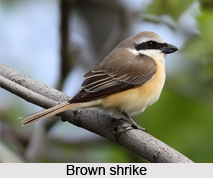 Brown Shrike is an Indian bird that bears a scientific name "Lanius cristatus" found mainly in Asian countries like India, Srilanka, Pakistan, Bangladesh, Afganistan, Vietnam, Laos and Thailand.
Brown Shrike is an Indian bird that bears a scientific name "Lanius cristatus" found mainly in Asian countries like India, Srilanka, Pakistan, Bangladesh, Afganistan, Vietnam, Laos and Thailand.
Concentration of Brown Shrike
Brown Shrike is a bird in the shrike family that is found mainly in Asia. It is closely related to the red-backed shrike (L. collurio) and is a belline shrike (L. isabellinus). Like most other shrikes, it has a distinctive black "bandit-mask" through the eye and is found mainly in open scrub habitats, where it perches on the tops of thorny bushes in search of prey.
Population of Brown Shrike
Brown Shrike has several populations of this widespread species form, distinctive subspecies which breed in temperate Asia and migrate to their winter quarters in tropical Asia. They are sometimes found as vagrants in Europe and North America.
Structure of Brown Shrike
Brown Shrike is mainly brown on the upper parts and the tail is rounded. The black mask can be paler in winter and has a white brow over it. The underside is creamy with rufous flanks and belly. The wings are brown and lack any white "mirror" patches. Females tend to have fine scalloping on the underside and the mask is dark brown and not as well marked as in the male. The distinction is not easy to use in the field but has been tested with breeding birds in Japan where the female can be identified from the presence of a brood patch. The use of multiple measurements allows discrimination of the sex of about 90% of the birds. Subspecies lucionensis has grey crown shading into the brown upperparts and the rump appears more rufous than the rest of the upper back. The tail is brownish and not as reddish as the red-backed shrike. Younger birds of lucionensis have a brown crown and lack the grey on the head. Subspecies superciliosus has a broad white supercilium and a richer reddish crown. The tail is redder and tipped in white.
Breeding of Brown Shrike
The nominate form of Brown Shrike breeds in northern Asia from Mongolia to Siberia and winters in South Asia, Myanmar and the Malay Peninsula. The race confusus described from the same region is not well marked but is said to have a wider white brow and paler upperparts and is sometimes included within the nominate population. Subspecies superciliosus breeds on the islands of Sakhalin, Kuril and Japan and winters in Hainan, Sumatra, Java, and the Sundas. Subspecies lucionensis, sometimes known as the Philippine shrike breeds in Korea and eastern China wintering mainly in Taiwan and the Philippines but also on the Andaman Islands and in peninsular India. Stuart Baker suggested that the species may breed in the Cachar Hills of Assam but the idea was questioned by Claud Buchanan Ticehurst. Brown shrike is rare in Europe and vagrants have been recorded in the United States and Canada.
 Migration of Brown Shrike
Migration of Brown Shrike
Brown Shrike is a migratory species and ringing studies show that they have high fidelity to their wintering sites, often returning to the same locations each winter. They begin establishing wintering territories shortly after arrival and their loud chattering or rattling calls are distinctive. Birds that arrive early and establish territories appear to have an advantage over those that arrive later in the winter areas. The timing of their migration is very regular with their arrival in winter to India in August and September and departure in April. During their winter period, they go through a pre-migratory moult. Their song in the winter quarters is faint and somewhat resembles the call of the rosy starling and often includes mimicry of other birds. The beak remains closed when singing and only throat pulsations are visible although the bird moves its tail up and down while singing.
Feeding of Brown Shrike
Brown Shrike feed mainly on insects, especially Lepidoptera. Like other shrikes, they impale prey on thorns. Small birds and lizards are also sometimes preyed upon. A White-Eye Brown Shrike has been recorded in its larder. They typically look out for prey from a perch and fly down towards the ground to capture them.











